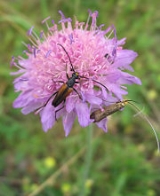
Knautia arvensis
Encyclopedia
Knautia arvensis, commonly known as Field Scabious, is a species in the genus Knautia
.
It is a perennial plant that grows between 25 and 100 cm. It prefers grassy places and dry soils, avoiding heavy soils, and flowers between July and September. The flowered head is flatter than similar species Devils bit scabious and Small Scabious. There are 4 stamens in each flower, and 1 notched long stigma.
The fruit is nut like, cylindrical and hairy, 5–6 mm in size.
It has a tap root. The stem has long stiff hairs angled downwards. There are no stipules.
The leaves form a basal rosette
, are paired on the stem, the lowest typically 300 mm long, spear shaped, whereas the upper are smaller.
It is occasionally used by the Marsh Fritillary
as a foodplant instead of its usual foodplant of Devils Bit Scabious (Succisa pratensis
). It is also the foodplant of the Narrow-bordered Bee Hawk-moth Hemaris tityus
.
, and may other afflictions of the skin including sores caused by the Bubonic Plague
1. The word scabies comes from the Latin
word for "scratch" (scabere). Another name for this plant is Gipsy Rose3.
The genus Knautia is named after a 17th century German botanist, Dr Knaut.
Knautia
Knautia is a genus in the family Dipsacaceae. The common names of these flowers are a variant of "widow flower." Others are given the name "Scabious," although this word belongs to a related genus .Species include:...
.
It is a perennial plant that grows between 25 and 100 cm. It prefers grassy places and dry soils, avoiding heavy soils, and flowers between July and September. The flowered head is flatter than similar species Devils bit scabious and Small Scabious. There are 4 stamens in each flower, and 1 notched long stigma.
The fruit is nut like, cylindrical and hairy, 5–6 mm in size.
It has a tap root. The stem has long stiff hairs angled downwards. There are no stipules.
The leaves form a basal rosette
Rosette (botany)
In botany, a rosette is a circular arrangement of leaves, with all the leaves at a single height.Though rosettes usually sit near the soil, their structure is an example of a modified stem.-Function:...
, are paired on the stem, the lowest typically 300 mm long, spear shaped, whereas the upper are smaller.
It is occasionally used by the Marsh Fritillary
Marsh Fritillary
The Marsh Fritillary, Euphydryas aurinia, is a butterfly of the Nymphalidae family.It is widespread in the Palaearctic region from Ireland in the West to Yakutia in the East, and to North-west China and Mongolia in the South.E. aurinia is represented by many subspecies.The most widely accepted...
as a foodplant instead of its usual foodplant of Devils Bit Scabious (Succisa pratensis
Succisa pratensis
Succisa pratensis Moench, also known as Devil's-bit Scabious, is a flowering plant of the genus Succisa in the family Dipsacaceae. It differs from other similar species in that it has 4 lobed flowers, whereas Small Scabious and Field scabious have 5 lobes and hence it has been placed in a separate...
). It is also the foodplant of the Narrow-bordered Bee Hawk-moth Hemaris tityus
Hemaris tityus
Hemaris tityus, the Narrow-bordered Bee Hawk-moth, is one of two similar species of sphingid moth occurring in Britain that closely mimic a bumblebee. It has a wide range, from Ireland across temperate Europe to the Ural Mountains, western Siberia, Novosibirsk and the Altai...
.
Name
Species of scabious were used to treat ScabiesScabies
Scabies , known colloquially as the seven-year itch, is a contagious skin infection that occurs among humans and other animals. It is caused by a tiny and usually not directly visible parasite, the mite Sarcoptes scabiei, which burrows under the host's skin, causing intense allergic itching...
, and may other afflictions of the skin including sores caused by the Bubonic Plague
Bubonic plague
Plague is a deadly infectious disease that is caused by the enterobacteria Yersinia pestis, named after the French-Swiss bacteriologist Alexandre Yersin. Primarily carried by rodents and spread to humans via fleas, the disease is notorious throughout history, due to the unrivaled scale of death...
1. The word scabies comes from the Latin
Latin
Latin is an Italic language originally spoken in Latium and Ancient Rome. It, along with most European languages, is a descendant of the ancient Proto-Indo-European language. Although it is considered a dead language, a number of scholars and members of the Christian clergy speak it fluently, and...
word for "scratch" (scabere). Another name for this plant is Gipsy Rose3.
The genus Knautia is named after a 17th century German botanist, Dr Knaut.

